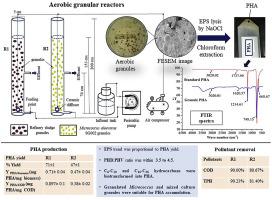当前位置:
X-MOL 学术
›
Int. Biodeterior. Biodegrad.
›
论文详情
Our official English website, www.x-mol.net, welcomes your
feedback! (Note: you will need to create a separate account there.)
Production of polyhydroxyalkanoates (PHA) from aerobic granules of refinery sludge and Micrococcus aloeverae strain SG002 cultivated in oily wastewater
International Biodeterioration & Biodegradation ( IF 4.1 ) Pub Date : 2020-11-01 , DOI: 10.1016/j.ibiod.2020.105091 Sayanti Ghosh , Saswati Chakraborty
International Biodeterioration & Biodegradation ( IF 4.1 ) Pub Date : 2020-11-01 , DOI: 10.1016/j.ibiod.2020.105091 Sayanti Ghosh , Saswati Chakraborty

|
Abstract This study investigates on accumulation of polyhydroxyalkanoates (PHA) biopolymers in aerobic granules having mixed sludge and pure strain inoculum while treating oily wastewater in aerobic granular reactors (AGRs). AGR operation improved granule size (4.51 ± 0.13 mm), volatile suspended solids (VSS: 7.54 ± 0.16 g/L) and extracellular polymeric substances content (EPS: 409.36 ± 1 mg/g VSS) with 90 ± 1% chemical oxygen demand (COD) and hydrocarbon removal in refinery sludge granules. Small sized (0.71 ± 0.04 mm) Micrococcus aloeverae strain SG002 granules achieved 81.40 ± 0.2% hydrocarbon removal efficiency accumulating 0.47 ± 0.01 mg PHA/mg cell dry weight (CDW) due to cocci populated strong microbial structure. Changing organic loading (0.6–1.8 kg COD/m3. day) and high C/N (8–24) stimulated 0.71 ± 0.04 mg PHA/mg CDW yield in the refinery granules. Long and short chain n-alkanes (C16–C36, C6–C10) were mostly transformed into PHA and nondegraded fractions remained in AGR effluents. About 40–70% PHA was accumulated in feast phase which was mostly utilized for microbial metabolism in famine phase. PHA yield per unit COD removal ranged between 0.38 to 0.89 mg PHA/mg COD. PHA production proportionally increased with EPS concentrations. Granule extracted PHA was characterized as co-polymer P (3HB-co-3HV) having 3.5–4.5 of butyrates to valerates (PHB:PHV) ratios. Hence, the study provides a simultaneous process of oil removal and bioplastic production with environmental impacts.
中文翻译:

从炼油厂污泥的好氧颗粒和含油废水中培养的芦荟微球菌菌株 SG002 生产聚羟基链烷酸酯 (PHA)
摘要 本研究调查了在好氧颗粒反应器 (AGR) 中处理含油废水时聚羟基链烷酸酯 (PHA) 生物聚合物在具有混合污泥和纯菌株接种物的好氧颗粒中的积累。AGR 操作改善了颗粒大小 (4.51 ± 0.13 mm)、挥发性悬浮固体 (VSS: 7.54 ± 0.16 g/L) 和细胞外聚合物物质含量 (EPS: 409.36 ± 1 mg/g VSS),化学需氧量 90 ± 1% ( COD) 和炼油厂污泥颗粒中的碳氢化合物去除。小型 (0.71 ± 0.04 毫米) 芦荟微球菌菌株 SG002 颗粒实现了 81.40 ± 0.2% 的碳氢化合物去除效率,由于球菌密集的微生物结构,累积 0.47 ± 0.01 mg PHA/mg 细胞干重 (CDW)。不断变化的有机负荷(0.6–1.8 kg COD/m3. 天)和高 C/N (8–24) 刺激了 0.71 ± 0。炼油厂颗粒中的 04 mg PHA/mg CDW 产量。长链和短链正构烷烃(C16-C36、C6-C10)大部分转化为 PHA,未降解的部分保留在 AGR 流出物中。大约 40-70% 的 PHA 在盛期积累,主要用于饥荒期的微生物代谢。每单位 COD 去除的 PHA 产量介于 0.38 至 0.89 毫克 PHA/毫克 COD 之间。PHA 产量随 EPS 浓度成比例增加。颗粒提取的 PHA 被表征为具有 3.5-4.5 的丁酸酯与戊酸酯 (PHB:PHV) 比率的共聚物 P (3HB-co-3HV)。因此,该研究提供了一个同时去除油和生物塑料生产对环境影响的过程。大约 40-70% 的 PHA 在盛期积累,主要用于饥荒期的微生物代谢。每单位 COD 去除的 PHA 产量介于 0.38 至 0.89 毫克 PHA/毫克 COD 之间。PHA 产量随 EPS 浓度成比例增加。颗粒提取的 PHA 被表征为具有 3.5-4.5 的丁酸酯与戊酸酯 (PHB:PHV) 比率的共聚物 P (3HB-co-3HV)。因此,该研究提供了一个同时去除油和生物塑料生产对环境影响的过程。大约 40-70% 的 PHA 在盛期积累,主要用于饥荒期的微生物代谢。每单位 COD 去除的 PHA 产量介于 0.38 至 0.89 毫克 PHA/毫克 COD 之间。PHA 产量随 EPS 浓度成比例增加。颗粒提取的 PHA 被表征为具有 3.5-4.5 的丁酸酯与戊酸酯 (PHB:PHV) 比率的共聚物 P (3HB-co-3HV)。因此,该研究提供了一个同时去除油和生物塑料生产对环境影响的过程。
更新日期:2020-11-01
中文翻译:

从炼油厂污泥的好氧颗粒和含油废水中培养的芦荟微球菌菌株 SG002 生产聚羟基链烷酸酯 (PHA)
摘要 本研究调查了在好氧颗粒反应器 (AGR) 中处理含油废水时聚羟基链烷酸酯 (PHA) 生物聚合物在具有混合污泥和纯菌株接种物的好氧颗粒中的积累。AGR 操作改善了颗粒大小 (4.51 ± 0.13 mm)、挥发性悬浮固体 (VSS: 7.54 ± 0.16 g/L) 和细胞外聚合物物质含量 (EPS: 409.36 ± 1 mg/g VSS),化学需氧量 90 ± 1% ( COD) 和炼油厂污泥颗粒中的碳氢化合物去除。小型 (0.71 ± 0.04 毫米) 芦荟微球菌菌株 SG002 颗粒实现了 81.40 ± 0.2% 的碳氢化合物去除效率,由于球菌密集的微生物结构,累积 0.47 ± 0.01 mg PHA/mg 细胞干重 (CDW)。不断变化的有机负荷(0.6–1.8 kg COD/m3. 天)和高 C/N (8–24) 刺激了 0.71 ± 0。炼油厂颗粒中的 04 mg PHA/mg CDW 产量。长链和短链正构烷烃(C16-C36、C6-C10)大部分转化为 PHA,未降解的部分保留在 AGR 流出物中。大约 40-70% 的 PHA 在盛期积累,主要用于饥荒期的微生物代谢。每单位 COD 去除的 PHA 产量介于 0.38 至 0.89 毫克 PHA/毫克 COD 之间。PHA 产量随 EPS 浓度成比例增加。颗粒提取的 PHA 被表征为具有 3.5-4.5 的丁酸酯与戊酸酯 (PHB:PHV) 比率的共聚物 P (3HB-co-3HV)。因此,该研究提供了一个同时去除油和生物塑料生产对环境影响的过程。大约 40-70% 的 PHA 在盛期积累,主要用于饥荒期的微生物代谢。每单位 COD 去除的 PHA 产量介于 0.38 至 0.89 毫克 PHA/毫克 COD 之间。PHA 产量随 EPS 浓度成比例增加。颗粒提取的 PHA 被表征为具有 3.5-4.5 的丁酸酯与戊酸酯 (PHB:PHV) 比率的共聚物 P (3HB-co-3HV)。因此,该研究提供了一个同时去除油和生物塑料生产对环境影响的过程。大约 40-70% 的 PHA 在盛期积累,主要用于饥荒期的微生物代谢。每单位 COD 去除的 PHA 产量介于 0.38 至 0.89 毫克 PHA/毫克 COD 之间。PHA 产量随 EPS 浓度成比例增加。颗粒提取的 PHA 被表征为具有 3.5-4.5 的丁酸酯与戊酸酯 (PHB:PHV) 比率的共聚物 P (3HB-co-3HV)。因此,该研究提供了一个同时去除油和生物塑料生产对环境影响的过程。











































 京公网安备 11010802027423号
京公网安备 11010802027423号